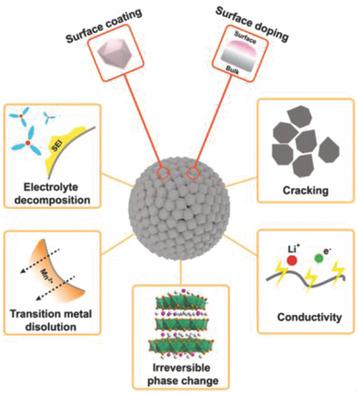当前位置:
X-MOL 学术
›
Adv. Energy Mater.
›
论文详情
Our official English website, www.x-mol.net, welcomes your feedback! (Note: you will need to create a separate account there.)
Surface and Subsurface Reactions of Lithium Transition Metal Oxide Cathode Materials: An Overview of the Fundamental Origins and Remedying Approaches
Advanced Energy Materials ( IF 27.8 ) Pub Date : 2018-09-03 , DOI: 10.1002/aenm.201802057 Biwei Xiao 1 , Xueliang Sun 1
Advanced Energy Materials ( IF 27.8 ) Pub Date : 2018-09-03 , DOI: 10.1002/aenm.201802057 Biwei Xiao 1 , Xueliang Sun 1
Affiliation

|
Lithium‐ion batteries (LIBs) have become one of the most prevailing techniques for rechargeable batteries. Lithium transition metal oxides are prevalent cathode materials currently, but they face great challenges due to unsatisfactory energy density, chemical/electrochemical instability, and elemental scarcity concerns. Surface/subsurface is the interface where lithium ions cross between the electrolyte and the cathode materials. Its properties and complicated nature are unambiguously regarded as a crucial controlling factor for the overall performance. Tremendous efforts have been made in the exploration of surface modification methods with remarkable progress hitherto. The purpose of this work is to review these surface behaviors in order to understand their fundamental origins and provide a summary of various surface modification methods that can be used to address impeding issues. Finally, a rational method of surface modification is proposed for use in cathode materials.
中文翻译:

锂过渡金属氧化物阴极材料的表面和次表面反应:基本起源和补救方法概述
锂离子电池(LIB)已成为可充电电池最流行的技术之一。锂过渡金属氧化物目前是普遍的阴极材料,但是由于能量密度不令人满意,化学/电化学不稳定性以及元素稀缺性问题,它们面临着巨大的挑战。表面/次表面是锂离子在电解质和阴极材料之间交叉的界面。它的特性和复杂的特性被明确地视为整体性能的关键控制因素。迄今为止,在表面改性方法的探索方面已经做出了巨大的努力,并取得了显着的进展。这项工作的目的是审查这些表面行为,以了解其基本来源,并提供各种可用于解决阻碍性问题的表面改性方法的摘要。最后,提出了一种用于阴极材料的合理的表面改性方法。
更新日期:2018-09-03
中文翻译:

锂过渡金属氧化物阴极材料的表面和次表面反应:基本起源和补救方法概述
锂离子电池(LIB)已成为可充电电池最流行的技术之一。锂过渡金属氧化物目前是普遍的阴极材料,但是由于能量密度不令人满意,化学/电化学不稳定性以及元素稀缺性问题,它们面临着巨大的挑战。表面/次表面是锂离子在电解质和阴极材料之间交叉的界面。它的特性和复杂的特性被明确地视为整体性能的关键控制因素。迄今为止,在表面改性方法的探索方面已经做出了巨大的努力,并取得了显着的进展。这项工作的目的是审查这些表面行为,以了解其基本来源,并提供各种可用于解决阻碍性问题的表面改性方法的摘要。最后,提出了一种用于阴极材料的合理的表面改性方法。



























 京公网安备 11010802027423号
京公网安备 11010802027423号